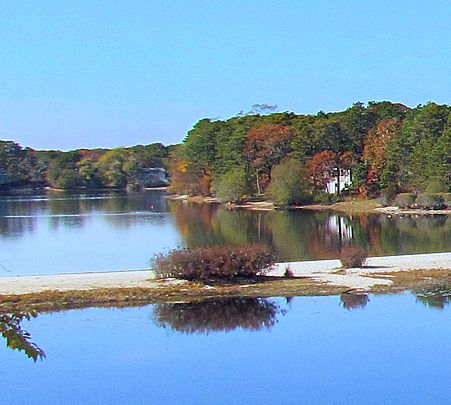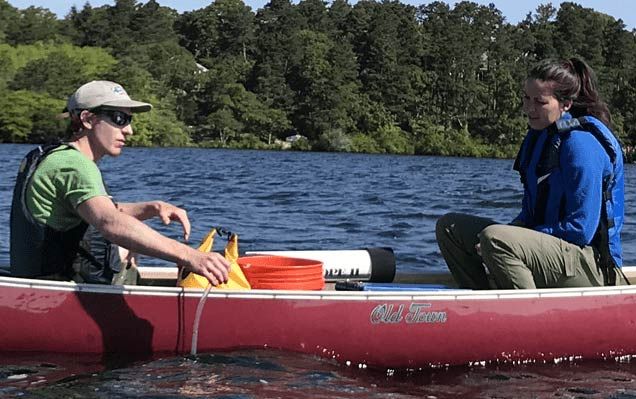Water Quality
Frequently Asked Questions
Ever wonder how the GSLA will respond to beach closures required by the Town Board of Health or an algae/bacterial bloom?
The GSLA Board of Directors has approved a protocol on how to quickly communicate to everyone using the beaches of issues with the water.
As pollution worsens on Cape Cod, some are investing hopes in a new type of septic system
BARNSTABLE — For years, pollution from septic systems has spawned algae blooms,toxic bacteria, and a putrid scum coating the waters of Cape Cod, destroying vitalecosystems, contributing to coastal erosion, and harming tourism.
“The water that comes from this system is treated to such a high degree that it’s almostpotable,” said Zenas Crocker, executive director of the Barnstable Clean Water Coalition,which has been overseeing a pilot project here that is installing the new septic systems atno cost to homeowners. “We see this as having an easier runway for expansion thansewers; they can be built more quickly and lower tax bills.”
The pollution has also spawned billion-dollar plans to dig up roads and install extensivesewer systems that local officials say is essential to cleaning up bays, estuaries, and pondsfrom Bourne to Brewster.
The Public Waterfront Act ("Chapter 91")
The Public Waterfront Act ("Chapter 91") and its regulations, 310 CMR 9.00, require a Chapter 91 waterways license or permit for any activity in, under, or over flowed tidelands, filled tidelands, Great Ponds, and certain non-tidal rivers and streams located throughout the Commonwealth. This link to the Massachusetts Department of Environmental Protection Chapter 91 licensing requirements for "Placement, construction or alteration of any structure, regardless of size, whether permanent or seasonal" such as docks attached to the shoreline.
Association to Preserve Cape Cod's Freshwater Ponds
Massachusetts General Laws, Part I, Title XIX, Section 40 covering lands bordering wetlands.
Harwich Wastewater Handbook – Final
Aluminum treatments to control internal phosphorus loading in lakes on Cape Cod
Ten lakes on Cape Cod have been treated with aluminum since 1995, with 2 of those lakes receiving a second treatment. Elimination of cyanobacterial blooms was the goal in each case. Aluminum sulfate and sodium aluminate were used in treatments with the intent to maintain a near-neutral pH in low alkalinity waters. Results varied, although all treatments lowered total phosphorus, provided relief from blooms, increased water clarity, and reduced oxygen demand for multiple years. Important lessons learned over 2 decades include how to apply aluminum to prevent fish mortality, options for dose calculation, and expectations for duration of benefits. Aluminum treatment has been demonstrated as a valued lake management tool to improve water quality and reduce nuisance algal blooms in Cape Cod lakes.
Harwich Comprehensive Wastewater Management Plan – Final
Weed Assessment
Harwich Wetland Protection Regulations
This PDF outlines the Harwich additions/clarifications of the Massachusetts wetland rules. A must read for everyone within 100 feet of a pond or wetland. You’ll be surprised at some of the rules.
Harwich Ponds, 2009-2010 Data Review
A cross town comparison of freshwater ponds comparing 2009 and 2010 data to previous years. Based in part on data our residents have been collecting for John Joseph and Bucks ponds.
Case Study of Great Sand Lakes
This is a 10 page Cape Cod Commission Executive Summary to the 2007 town report on Wastewater Management (above). A much easier read.
Massachusetts Lake and Pond Guide
Weekly Testing results. We’re working with the Harwich Natural Resources Officer to bring these to you.
Great Sand Lakes Water Quality Update (6/23/2023)

Comprehensive Wastewater Management Plan (CWMP)
The Town of Harwich was seeking public comment on suggested revisions, edits or improvements to the Comprehensive Wastewater Management Plan (CWMP) which outlines the procedures and timeline for the construction of sewers throughout the town. The GSLA neighborhood is currently scheduled to undergo sewage construction only in Phase 8 (2048-2052).
The public comment meetings were held to advocate for expediting the sewage construction process so that we can better protect the water quality of our ponds. Baseline water quality is deteriorating due to increased nutrient content from septic systems and other sources. There is new federal funding available for Wastewater Treatment through ARPA Funds that could be used to expedite sewer constuction.
Brewster Ponds Summit June 17, 2022
Brewster Ponds Summit June 17, 2022 (Continued)
Protect Our Ponds March 30, 2022
January 27, 2022 Meeting
Virtual public input session.
February 12, 2022 Meeting
Dan Pelletier's overview presentation.
Dan Pelletier's overview presentation and public comments.
Cyanobacteria Monitoring

Cyanobacteria are commonly found in the phytoplankton community of aquatic ecosystems. They form the base of the food web of freshwater ponds and streams that flow into coastal estuaries and the ocean. The presence of cyanobacteria is natural and important!
However, overabundant cyanobacterial growth (called blooms) and their release of dangerous amounts of cyanotoxins appear to be occurring more frequently. This is due to warming global temperatures and excessive nutrients in our ponds. This excessive growth of cyanobacteria and formation of blooms degrades habitats and damages the environment. Exposure to cyanotoxins can have serious health implications for wildlife, humans, and pets.